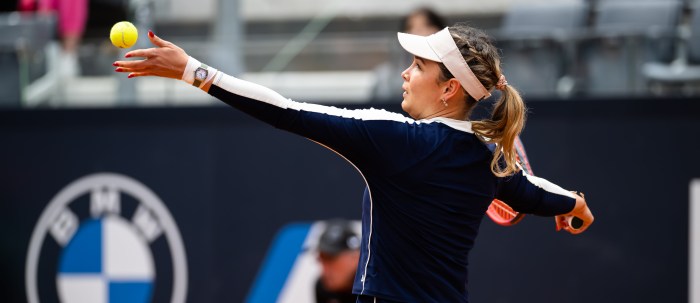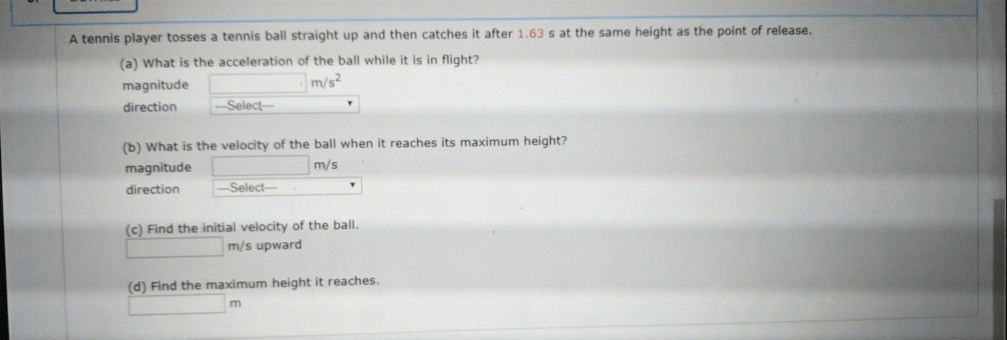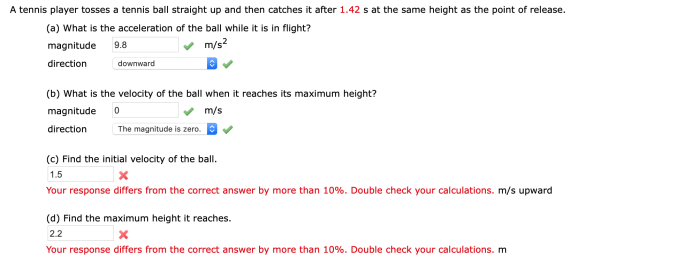A tennis player tosses a tennis ball, a seemingly simple act that belies a complex interplay of physics, technique, and strategy. This comprehensive guide delves into the intricacies of the tennis ball toss, exploring its impact on game performance and providing practical tips for improvement.
From the forces acting on a ball in flight to the biomechanics of an effective toss, this guide covers all aspects of this essential tennis skill. It examines different types of tosses, practice drills, and advanced techniques used by professional players.
Tennis Ball Toss Physics

The toss of a tennis ball is a complex motion that involves several physical principles. As the ball is released from the player’s hand, it is subject to various forces that determine its trajectory and behavior.
Forces Acting on a Tennis Ball During a Toss
- Gravity:The primary force acting on the ball is gravity, which pulls it downwards towards the ground.
- Lift:As the ball spins, it creates a pressure difference between its surfaces, resulting in an upward force known as lift.
- Magnus Effect:The combination of spin and airflow around the ball generates a sideways force called the Magnus effect.
- Drag:The resistance encountered by the ball as it moves through the air is known as drag.
Trajectory of a Tennis Ball Toss
The trajectory of a tennis ball toss is influenced by the interplay of these forces. Initially, the ball moves upwards due to the initial velocity imparted by the player. As gravity acts upon it, the ball begins to decelerate and reach its peak height.
At this point, the upward force of lift and the sideways force of the Magnus effect become more prominent, causing the ball to curve and descend.
Factors Impacting the Toss
Several factors can affect the toss of a tennis ball, including:
- Ball Weight:Heavier balls experience greater gravitational force, resulting in a lower peak height and shorter hang time.
- Spin:Imparting spin on the ball enhances lift and the Magnus effect, allowing for greater control and accuracy.
- Air Resistance:The density and viscosity of the air can impact drag, affecting the ball’s trajectory and speed.
Technique and Biomechanics
An effective tennis ball toss requires a combination of proper technique and understanding of the underlying biomechanics.
The proper technique involves holding the ball lightly with the fingertips of the non-dominant hand, with the thumb resting on the top of the ball. The dominant arm should be extended overhead, with the elbow slightly bent and the wrist relaxed.
Key Biomechanical Factors
- Balance:Maintaining balance during the toss is crucial for accuracy. The feet should be shoulder-width apart, with the weight evenly distributed.
- Shoulder Rotation:The toss involves a controlled rotation of the shoulder joint. The shoulder should rotate externally during the backswing and internally during the forward swing.
- Elbow Flexion and Extension:The elbow should flex slightly during the backswing and extend during the forward swing. This movement provides the necessary power for the toss.
- Wrist Action:The wrist should remain relaxed throughout the toss, allowing for a smooth release of the ball.
Tips for Improving Accuracy and Consistency
- Practice Regularly:Consistent practice is key to improving toss accuracy and consistency.
- Focus on Balance:Pay attention to maintaining balance during the toss to ensure a stable base.
- Use a Visual Target:Practice tossing the ball to a specific target on the court to improve accuracy.
- Experiment with Grip:Experiment with different grip positions to find what feels most comfortable and consistent.
Types of Tosses

Tennis ball tosses can be categorized into various types, each serving a specific purpose and executed with a distinct technique.
The following table summarizes the different types of tennis ball tosses:
| Toss Name | Purpose | Execution |
|---|---|---|
| Underhand Toss | Standard toss for serves | Ball is held in the non-dominant hand and tossed underhand, with the elbow bent and the arm extended upwards. The ball is released at the highest point of the toss. |
| Overhead Toss | For high-bouncing serves | Ball is held in the dominant hand and tossed overhead, with the arm extended upwards and the elbow slightly bent. The ball is released at the highest point of the toss. |
| Sidearm Toss | For serves with more spin | Ball is held in the non-dominant hand and tossed sidearm, with the arm extended outwards and the elbow bent. The ball is released at the highest point of the toss. |
| Lob Toss | For high-arching shots over the opponent’s head | Ball is held in the dominant hand and tossed high overhead, with the arm extended upwards and the elbow slightly bent. The ball is released at the highest point of the toss. |
| Drop Toss | For low-bouncing shots that land just over the net | Ball is held in the non-dominant hand and dropped just above the net, with the arm extended downwards and the elbow slightly bent. The ball is released at the lowest point of the toss. |
Practice Drills

Practice drills are an essential part of enhancing toss accuracy in tennis. They provide players with the opportunity to develop consistency and control in their tosses, ensuring that they can deliver the ball to the desired spot in the service box.
Incorporating these drills into training routines offers numerous benefits. They help players improve their muscle memory, develop a consistent rhythm, and gain a better understanding of the biomechanics involved in the toss. Additionally, regular practice helps build confidence and reduce the likelihood of double faults.
Drill 1: Wall Toss
- Stand facing a wall, approximately 10 feet away.
- Toss the ball against the wall, aiming for a specific target.
- Focus on maintaining a consistent height and trajectory.
- Repeat the process multiple times, aiming for accuracy and consistency.
Drill 2: Target Toss
- Place a target, such as a cone or small hoop, on the ground.
- Stand a few feet away from the target and practice tossing the ball into it.
- Adjust the distance gradually to challenge your accuracy.
- Repeat the drill from various angles and distances to improve consistency.
Drill 3: Partner Toss
- Work with a partner who will stand across the net from you.
- Practice tossing the ball to your partner, aiming for their non-dominant hand.
- The partner should provide feedback on the accuracy and consistency of the tosses.
- Reverse roles and repeat the process to enhance both players’ skills.
Impact on Game Performance
A consistent and accurate toss is paramount in tennis, as it directly influences the quality and effectiveness of the subsequent shot.
A poor toss can negatively impact game performance in several ways:
- Inconsistent ball height and trajectory:A poor toss can result in the ball being tossed too high, too low, or with an unpredictable trajectory, making it difficult for the player to hit the ball cleanly.
- Limited time to prepare:A poorly timed toss can leave the player with insufficient time to set up for the shot, leading to rushed and inaccurate strokes.
- Increased risk of double faults:In serves, a poor toss can increase the likelihood of a double fault, as the player may struggle to hit the ball within the service court.
Strategies for Maintaining Toss Quality
To maintain toss quality during matches, players can employ the following strategies:
- Practice regularly:Consistent practice is crucial for developing a reliable toss. Players should practice tossing the ball in different conditions and from various distances.
- Focus on the target:When tossing the ball, players should focus on a specific target on the court. This helps ensure accuracy and consistency.
- Use a consistent grip:Maintaining a consistent grip on the ball during the toss promotes stability and control.
- Stay relaxed:Tension can lead to inconsistent tosses. Players should stay relaxed and focused on the task at hand.
Equipment Considerations
Tennis ball characteristics play a crucial role in toss performance. Factors to consider when selecting a ball for tossing include:
Ball Weight
The weight of the ball influences its trajectory and bounce height. Heavier balls provide more control and stability, while lighter balls offer greater distance and spin potential.
Ball Pressure
Pressure affects the ball’s bounce and spin characteristics. Higher-pressure balls bounce higher and provide less spin, while lower-pressure balls bounce lower and generate more spin.
Ball Material
The material of the ball’s cover affects its durability and playing characteristics. Natural rubber covers provide excellent grip and control, while synthetic covers offer increased durability and consistency.
Ball Surface
The surface of the ball can impact its trajectory and spin. Smooth balls provide a more consistent flight, while textured balls generate more spin and grip.
Recommendations
For optimal toss performance, consider the following recommendations:
- Use heavier balls for control and stability in windy conditions.
- Opt for lighter balls for increased distance and spin potential in calm conditions.
- Choose higher-pressure balls for high-bounce surfaces and lower-pressure balls for low-bounce surfaces.
- Select natural rubber balls for enhanced grip and control, or synthetic balls for durability and consistency.
- Choose balls with textured surfaces for increased spin and grip.
Advanced Techniques
Professional tennis players employ advanced tossing techniques to enhance their serves and improve their overall performance on the court.
These techniques include:
Toss Height and Distance
- High Toss:A high toss allows for more time to prepare and generate power, resulting in a faster and more accurate serve.
- Low Toss:A low toss reduces the time available for the opponent to react, making it more difficult to return the serve.
- Deep Toss:A deep toss gives the server more time to move into the court and take advantage of the open space.
- Short Toss:A short toss forces the server to hit the ball quickly, often leading to a more compact and powerful serve.
Toss Spin
- Topspin Toss:A topspin toss imparts a forward rotation on the ball, causing it to dip down into the court and bounce higher.
- Backspin Toss:A backspin toss imparts a backward rotation on the ball, causing it to rise up and bounce lower.
- Sidespin Toss:A sidespin toss imparts a sideways rotation on the ball, causing it to curve to the left or right.
Toss Placement
- Center Toss:A center toss places the ball directly above the server’s head, allowing for a balanced and consistent serve.
- Wide Toss:A wide toss places the ball to the side of the server’s head, creating an angle that can be difficult for the opponent to return.
- Forward Toss:A forward toss places the ball in front of the server’s head, giving them more time to prepare and generate power.
Training and Development: A Tennis Player Tosses A Tennis Ball

To develop a consistent tennis ball toss, a comprehensive training program is crucial. It should incorporate a range of exercises, drills, and a well-defined progression plan.
Regular practice is paramount for improving toss accuracy. Feedback from coaches or peers can be invaluable in identifying areas for improvement.
Exercises
- Overhead Wall Toss:Stand facing a wall, toss the ball overhead and aim to hit a specific target.
- Kneeling Toss:Kneel on the ground and toss the ball overhead, focusing on accuracy and consistency.
- Underhand Toss:Toss the ball underhand, aiming for a specific target.
Drills
- Progressive Distance Drill:Gradually increase the distance from which the ball is tossed while maintaining accuracy.
- Crosscourt Toss Drill:Toss the ball across the court to a partner, practicing both accuracy and distance control.
- Target Toss Drill:Place cones or targets at various distances and practice tossing the ball into each target.
Progression Plan, A tennis player tosses a tennis ball
- Accuracy Phase:Focus on tossing the ball to a specific target, emphasizing consistency.
- Distance Phase:Gradually increase the distance of the toss while maintaining accuracy.
- Integration Phase:Practice tossing the ball in a live game situation, combining accuracy and distance.
FAQ Resource
What are the key factors that affect the trajectory of a tennis ball toss?
Ball weight, spin, air resistance, and the angle of release.
How can I improve the accuracy of my toss?
Practice regularly, focus on a consistent release point, and use proper biomechanics.
What are the different types of tennis ball tosses?
Underhand, overhand, sidearm, and lob.
How can I incorporate practice drills into my training routine?
Set up targets, use a wall or net, and practice with a partner.
What are some advanced tossing techniques used by professional players?
The “knuckleball” toss, the “banana” toss, and the “topspin” toss.